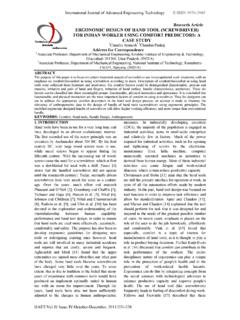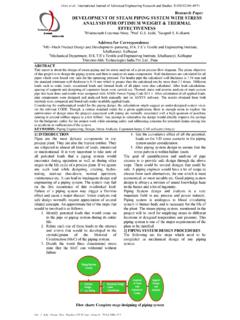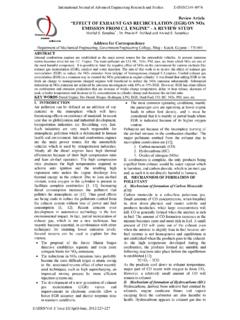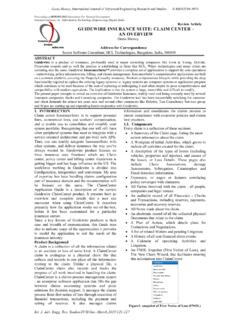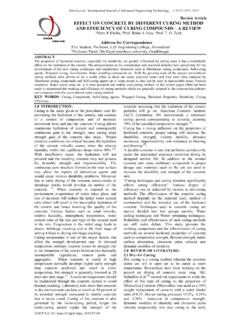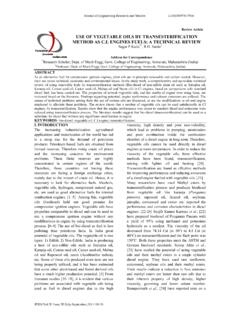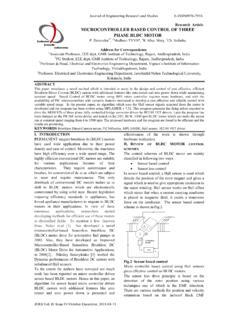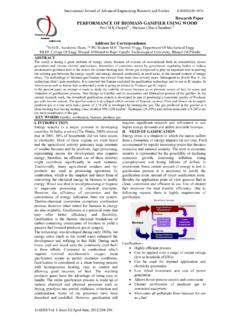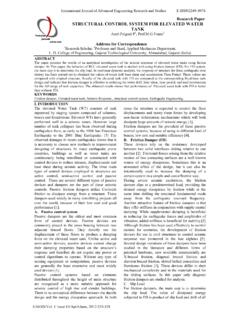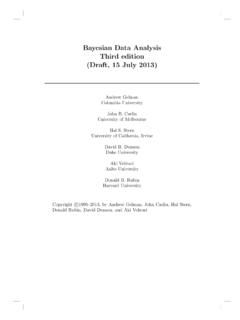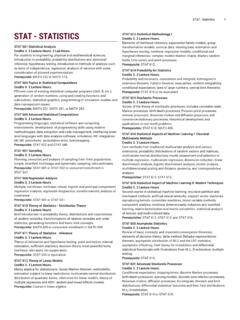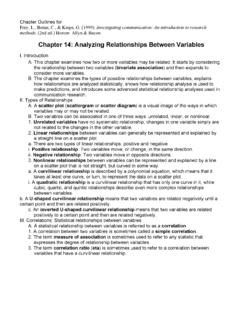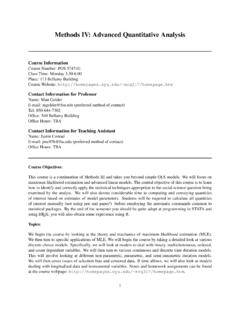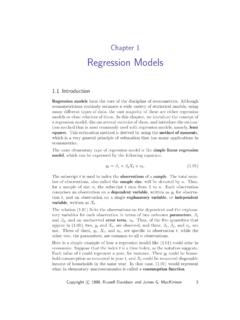Transcription of Research Article EVALUATION OF LOGISTIC REGRESSION …
1 International Journal of advanced Engineering Technology E-ISSN 0976-3945 Issue I/January-March 2011/228-233 Research Article EVALUATION OF LOGISTIC REGRESSION MODEL WITH FEATURE SELECTION methods ON MEDICAL DATASET 1 Raghavendra B. K., 2Dr. Jay B. Simha Address for Correspondence 1Dr. Educational and Research Institute, Chennai-600 095 2 Abiba Systems, Bengaluru-560 050 Email: ABSTRACT LOGISTIC REGRESSION is a well known classification method in the field of statistical learning.
2 It allows probabilistic classification and shows promising results on several benchmark problems. LOGISTIC REGRESSION enables us to investigate the relationship between a categorical outcome and a set of explanatory variables. The outcome or response can be either dichotomous (yes, no) or ordinal (low, medium, high). During dichotomous response, we are performing standard LOGISTIC REGRESSION and for ordinal response, we are fitting a proportional odds model. In this Research work an attempt has been made to introduce model that uses standard LOGISTIC REGRESSION formula with feature selection using forward selection and backward elimination methods and has been evaluated for the effectiveness of the results on publicly available medical datasets.
3 The process of EVALUATION is as follows. The feature selection algorithm using forward selection and backward elimination method is applied on the dataset and the selected features from these algorithms are used to develop a predictive model for classification using LOGISTIC REGRESSION . The classification accuracy, root mean square error, and mean absolute error are used to measure the performance of the predictive model. From the experimental results it is observed that LOGISTIC REGRESSION model with feature selection using forward selection and backward elimination methods gives more reliable result than the LOGISTIC REGRESSION model.
4 KEYWORDS Backward elimination, dichotomous variable, explanatory variable, feature selection, forward selection, LOGISTIC REGRESSION , medical dataset. I. INTRODUCTION In the last few years, digital revolution has provided relatively inexpensive and available means to collect and store large amounts of patient data in database, , containing rich medical information and made available through the Internet for Health Services globally. Data mining techniques LOGISTIC REGRESSION is applied on these databases to identify the patterns that are helpful in predicting or diagnosing the diseases and to take therapeutic measure of those diseases.
5 LOGISTIC REGRESSION is a technique for analyzing problems in which there are one or more independent variables that determine an outcome. The outcome is measured with a dichotomous variable (in which there are only two possible outcomes). In LOGISTIC REGRESSION , the dependent variable is binary or dichotomous, , it only contains data coded as 1 (TRUE, success, etc.) or 0 (FALSE, failure, etc.). The goal of LOGISTIC REGRESSION is to find the best fitting model to describe the relationship between the dichotomous characteristic of interest (dependent variable = response or outcome variable) and a set of independent (predictor or explanatory) variables.
6 LOGISTIC REGRESSION generates the coefficients of formula to predict a logit transformation for the probability of presence of characteristic of interest. The rest of the paper is organized as follows: Section 2 reviews the prior literature, LOGISTIC REGRESSION technique is discussed in Section 3. Experimental validation using publicly available medical dataset is given in Section 4. Section 5 includes Experimental results and discussions followed by conclusion. II. LITERATURE SURVEY There is an approach that examines the problem of efficient feature EVALUATION for LOGISTIC REGRESSION on very large data sets.
7 The authors present a new forward feature selection heuristic that ranks features by their estimated effect on the resulting model's performance. An approximate optimization, based on back fitting, provides a fast and accurate estimate of each new feature's coefficient in the LOGISTIC REGRESSION model. Further, the algorithm is highly scalable by parallelizing International Journal of advanced Engineering Technology E-ISSN 0976-3945 Issue I/January-March 2011/228-233 simultaneously over both features and records, allowing us to quickly evaluate billions of potential features even for very large data sets [3].
8 Recent studies of machine learning algorithms in high-dimensional data revealed that the three top performing classes of algorithms for high-dimensional data sets are LOGISTIC REGRESSION , Random Forests and SVMs [4]. Although LOGISTIC REGRESSION can be inferior to non-linear algorithms, kernel SVMs, for low-dimensional data sets, it often performs equally well in high-dimensions, when the number of features goes over 10000, because most data sets become linearly separable when the numbers of features become very large. Given the fact that LOGISTIC REGRESSION is often faster to train than more complex models like Random Forests and SVMs, in many situations it is the preferable method to deal with high dimensional data sets [5].
9 However, even with a scalable algorithm it can still be computationally infeasible to use the billions of features that could be potentially useful. The choice of features in high dimensions can have a significant effect on the performance of the learned model and the computational tractability of the learning algorithm. Many algorithm-independent high level feature selection techniques are exist, however, in most cases the running time becomes an issue for large numbers of features. Although popular and extremely well established in mainstream statistical data analysis, LOGISTIC REGRESSION is strangely absent in the field of data mining.
10 This Article introduces two possible explanations of this phenomenon. First, there might be an assumption that any tool which can only produce linear classification boundaries is likely to be trumped by more modern nonlinear tools. Second, there is a legitimate fear that LOGISTIC REGRESSION cannot practically scale up to the massive dataset sizes to which modern data mining tools are applied. This Article consists of an empirical examination of the first assumption, and surveys, implements and compares techniques by which LOGISTIC REGRESSION can be scaled to data with millions of attributes and records.
